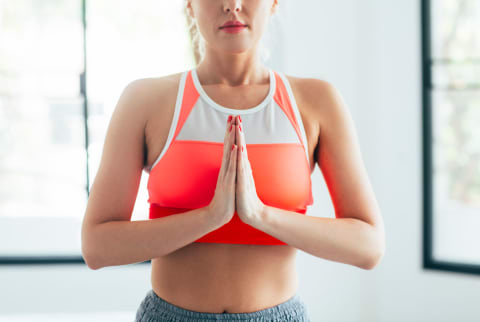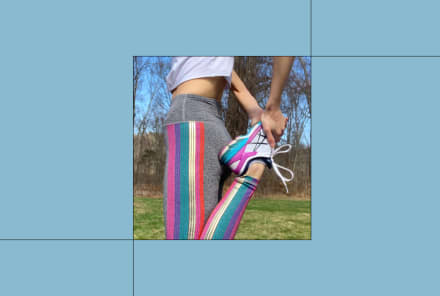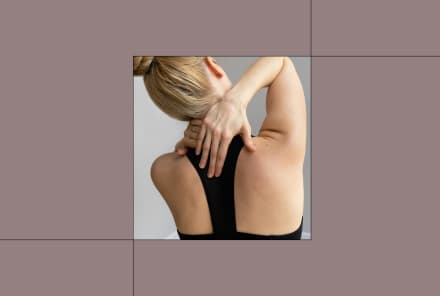Advertisement
A Hormone-Balancing Ayurvedic Ritual For Every Time Of Day


Stress interferes with our physiology, and for women, it often results in a hormonal imbalance of estrogen, progesterone, and testosterone. Each woman will experience this in her own way, but symptoms can include premenstrual symptoms (PMS), uterine fibroids, ovarian cysts, irregular menstrual cycles, or symptomatic menopause with mood changes, hair loss, and hot flashes. It would be best to address each of these individually (and under the care of a health care practitioner), yet because the source of many of these issues is stress, there are general approaches we can use to foster a healing environment for hormonal imbalances that women experience.
Menstrual cycles should not be symptomatic! We have come to accept PMS as being a normal thing that every woman experiences, but that isn't—and doesn't have to be—true. You can begin to work with your symptoms by identifying when they occur, pacifying the dosha at play. Symptoms during menstruation often indicate vata imbalance, occurring between menstruation and ovulation is kapha, and from the time of ovulation to menstruation is pitta. Tackling this issue on your own can be difficult, so be sure to enlist the help of your ayurvedic practitioner.
Hormones are governed by pitta, or the dosha made of fire and water. The period from puberty to menopause is the pitta stage of life and thus the time when most hormonal imbalances occur. When you couple this with a woman who is pitta-predominant and working in a masculine-leaning career or environment, the effects of the imbalance become amplified.
Because the vata stage is the period of life from menopause onward, menopause symptoms can be greatly decreased by pacifying both the pitta dosha (which governs female hormones) and vata. In fact, those who enter menopause with accumulated vata will experience more symptoms during this transition. During menopause, it's helpful to keep a regular schedule; choose gentle exercise like walking or yoga; use oil externally; and consume healthy fats by eating more nuts, seeds, and avocados.
Morning Ritual
Yin-Yang meditation (5 minutes)
Yin and yang are opposing energies, and one is unable to exist without the other. Yin represents feminine, lunar, or cooling energy whereas yang is masculine, solar, or heating energy. We invoke and express yin energy when we practice compassion, move slowly and freely, speak from the heart, and make decisions based on intuition. Yang is emphasized when we exercise our willpower, work hard to achieve goals, engage in competition, and work through problems with logic. In the body, the left side represents yin energy, and the right represents yang. This meditation is about keeping these energies in check so that it can become evident when we've been pushing too hard to manage the responsibilities of home, work, and personal life without time to retreat for the self-nurturing acts we need.
Begin seated with your back upright. Turn your palms faceup, with your elbows bent and hands at midchest height. Inhale and feel the yang energy of the muscles supporting you through your back and abdomen; exhale and feel the softness of the yin energy around your neck, shoulders, and hips. Now, think of the aspects of your current life that represent yin energy and imagine holding them in your left hand. How heavy or light does this feel? Think of the activities in your life that represent yang energy and hold them in your right hand. How does the weight feel in your right hand? Compare your two hands—is one more heavily weighted? Visualize the ways you can embrace these energies and allow them to be more equally represented in your life. Release your palms until they're facedown on your thighs. Take three deep breaths.
Midday Rituals
Balanced breathing (sama vritti, 3 minutes)
As we stay conscious of the concept of balance in the doshas and yin and yang energies, balanced breathing is an exceptional way of keeping an equilibrium in both body and mind.
For this exercise, start with a comfortable upright seat. Start with a clearing breath by breathing in through your nose and out through your mouth. With your next inhalation, breathe in through your nose to a count of four and hold your retention for a count of four. Exhale steadily through your nose using the same four count, and hold, empty of breath, for a count of four. This completes one cycle.
This breathing exercise is recommended for the middle of the day so that it can act as a reset. Though it would be best to be in a dedicated space or to sit on the floor with a meditation cushion or a blanket, the priority is to do this daily with consistency. Thus, you may find yourself pushing back from your desk and practicing this in your office chair or sitting in your car with the radio off (not while driving, of course!). No matter the setting, stay present and mindful as you breathe so that this can feel like the self-nurturing ritual that it is instead of another item on your agenda.
Retaining your breath or pausing while empty of breath can be considered an intermediate to advanced breathing practice. For some, it can cause strain or even anxiousness or panic. If breathwork is new to you, wait to advance to this in the breathing exercises you choose.
Evening Ritual
Tap into ajna marma (5 minutes)
We discussed marma points: vital areas of the body that correspond to different organs or conditions, which can be used to promote healing. For this ritual, we'll be drawing our awareness to ajna marma, which is located at the forehead midline, just slightly above eyebrow level, or at the space referred to as the third eye. Ajna marma is also called sthapani, and both names have similar meanings. Ajna means "order," and sthapani means "steadiness in the mind." While this implies balance, we use it to address female hormonal imbalance in particular because it is at the level of the pituitary gland. The pituitary gland is the master gland that releases the hormones that control all other glands. It is also a marma point that is used to relieve stress.
For this ritual, you can be either seated in your meditative posture or reclined on your back. Be comfortable but not so comfy that you could fall asleep. Using your left thumb, apply a gentle amount of pressure to anja marma. Continue this for five to seven breaths. Then, slowly make five circles in a clockwise direction, followed by five circles moving counterclockwise. As you release your hand from the point, let your arms rest comfortably and continue to keep your focus and attention on this point for 3 minutes.
Watch Next
Enjoy some of our favorite clips from classes
Enjoy some of our favorite clips from classes
What Is Meditation?
Mindfulness/Spirituality | Light Watkins
Box Breathing
Mindfulness/Spirituality | Gwen Dittmar
What Breathwork Can Address
Mindfulness/Spirituality | Gwen Dittmar
The 8 Limbs of Yoga - What is Asana?
Yoga | Caley Alyssa
Two Standing Postures to Open Up Tight Hips
Yoga | Caley Alyssa
How Plants Can Optimize Athletic Performance
Nutrition | Rich Roll
What to Eat Before a Workout
Nutrition | Rich Roll
How Ayurveda Helps Us Navigate Modern Life
Nutrition | Sahara Rose
Messages About Love & Relationships
Love & Relationships | Esther Perel
Love Languages
Love & Relationships | Esther Perel











